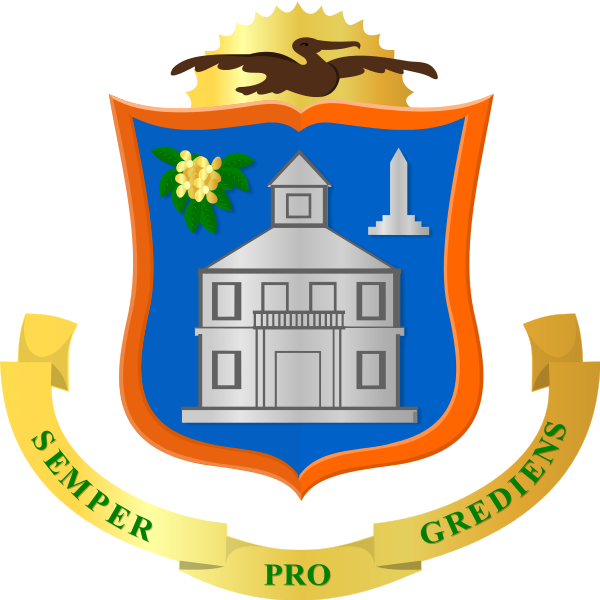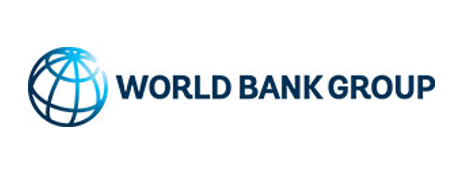Section 4: Opportunities for Sustainable and Resilient Development
FINDINGS
The discussions presented in the previous sections build a storyline capturing the rapid and somewhat disjointed growth and development of Sint Maarten during the past 30 years. This growth remains largely dependent on the tourism sector and its associated service requirements (detailed in section 2). The tourism sector which plays such a significant role in the economy is considered the key driver of growth for the island. In parallel, the small geographical area, restricted areas for expansion and tight population density continue to create significant challenges for sustainable growth in Sint Maarten. This CEA considers tourism development as the Key Driver of growth along together with population increase of the long term residents and short term in migration of seasonal tourism workers and public and private services for the island residents and tourist visitors.
As pointed out in earlier passages of this report, there is a large body of analysis and evidence calling for alternative development planning and management in Sint Maarten’s. Government attention to these challenges include the recent Ministry Plan approach for sustainable development by VROMI (2015) as well as the framework for sustainable development (UNDP 2016) that provides excellent building blocks and actions to achieve the SD goals. A collection of international consultancies along with local NGO studies and reports (CTO 2017, 2018; EPIC 2015; SHTA 2015, Nature Foundation 2015, EU 2012; reinforce the concept that there are limits to growth in the former Dutch jurisdiction.
In recent years, increasing attention has been paid to the impacts of tourism and related developments upon the environment throughout the Caribbean. There is an increasing acceptance of the concept of sustainable tourism development. While tourism is dependent upon the environment – scenic beauty, beautiful beaches, diving adventures, sailing, yachting and fishing excursions - a lack of knowledge, responsibility, and long-term planning has often resulted in development which is neither environmentally nor culturally sympathetic to the tourist destination and associated communities.
Establishing a broad definition of environment is necessary in this context, encompassing an appreciation of the cumulative pressures from the Drivers of development in Sint Maarten and the resulting impacts on the environment, natural resources and cultural fabric. Improved understanding of the complex nature of tourism development, and of its linkages to the environment, is crucial if a sustainable relationship is to be attained and maintained.
It is necessary to appreciate that tourist destination areas evolve and change over time, both responding to, and being altered by, changes in tourism demand and global economic conditions. Coordination of policies, pro-active planning, acceptance of limitations on growth, education of all parties involved, and commitment to a long-term viewpoint, are prerequisites to the successful linking of tourism and sustainable development. If the trajectory of tourism growth continues on Sint Maarten and development charges ahead unchecked, the island is certain to be a prime example of “Tragedy of the Commons”.
The impact of Irma sidetracked much of the strategic sustainable development planning programs in Sint Maarten to focus on disaster response and recovery. But, the GOSM still has a vision for economic development, incorporating the principles of Building Back Better in its National Recovery and Resilience Plan (see section 1, Introduction).
Main environmental concerns for the island are based on activities related to 1) health services, 2) solid waste, 3) wastewater management, 4) flooding and drainage, 5) electrical generation and supply, 6) drinking water generation and supply, 7) transport and traffic, and 8) climate change and natural hazards. The e-Book includes separate sections (hyperlinks are provided) for these environmental pressures to discuss the current situations and how they create environmental impacts on the island. These activities create environmental pressures on drivers of the sustainable growth. The Sint Maarten e-CEA focuses on three drivers which are 1) resident and service population increase, 2) tourism development and expansion, and 3) development growth and public and private services. While Sint Maarten is growing based on these drivers, there are impacts on several sectors which are listed in the Figure 1 which presents the key themes and sectors of the Sint Maarten e-CEA.
To learn more, place the mouse over the image.
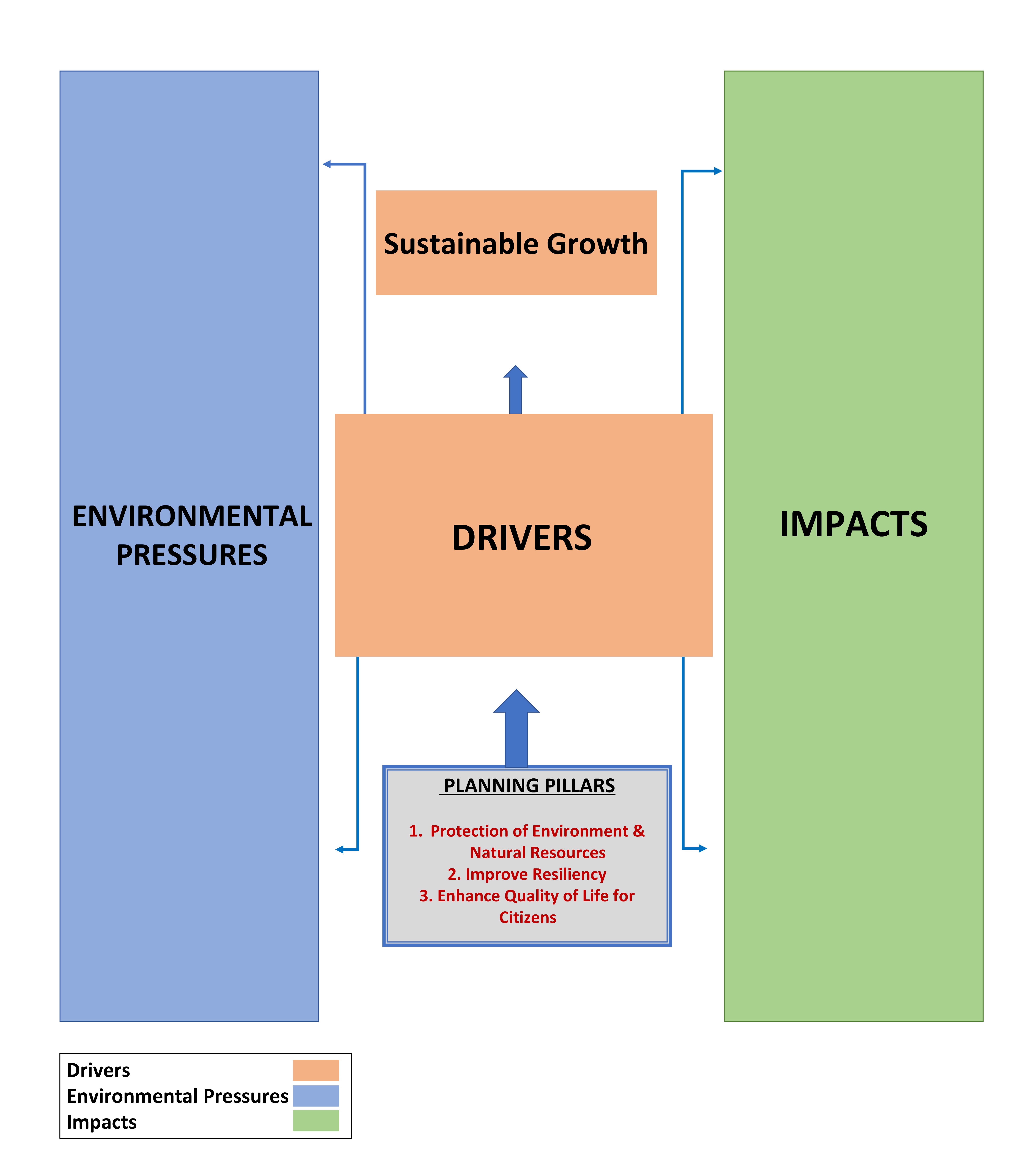
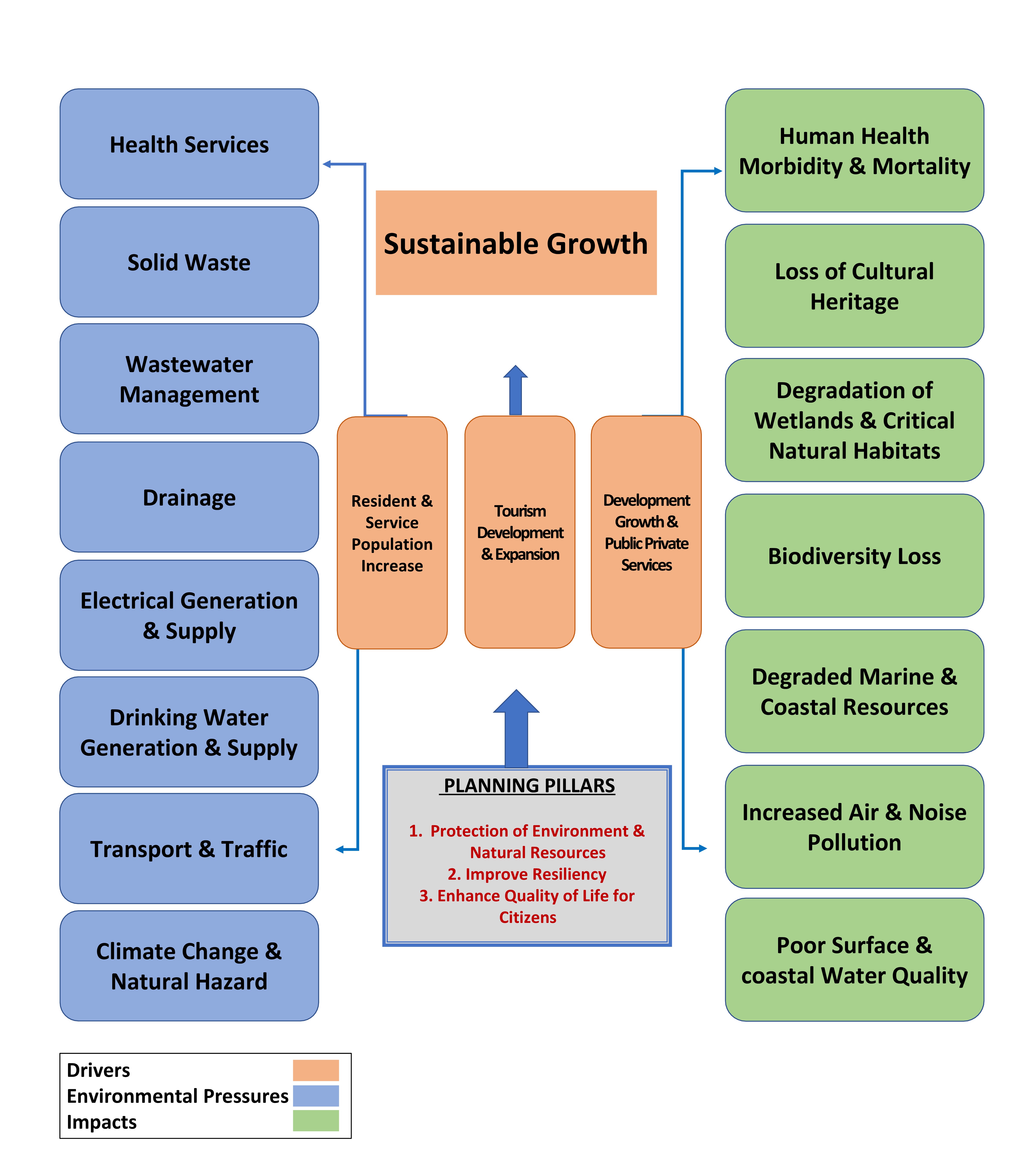
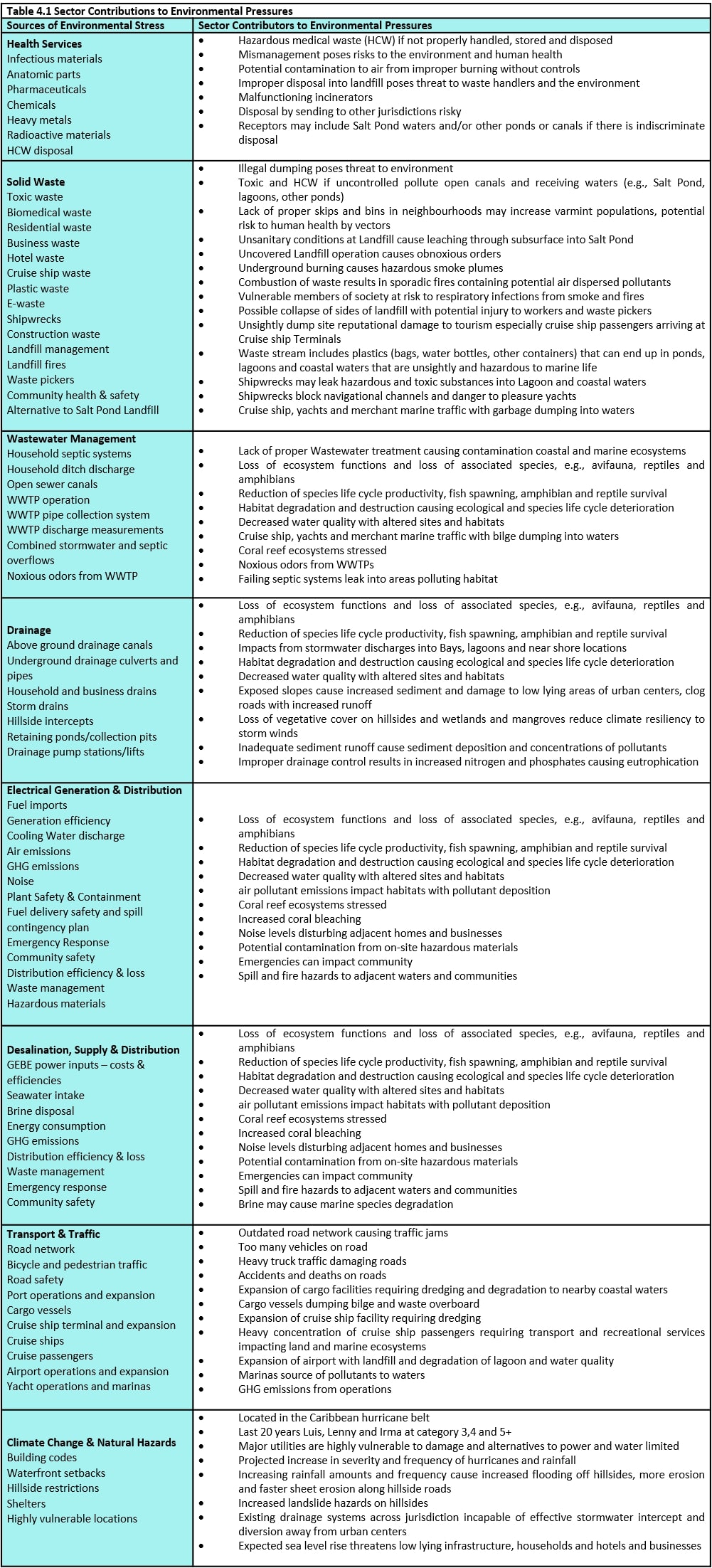
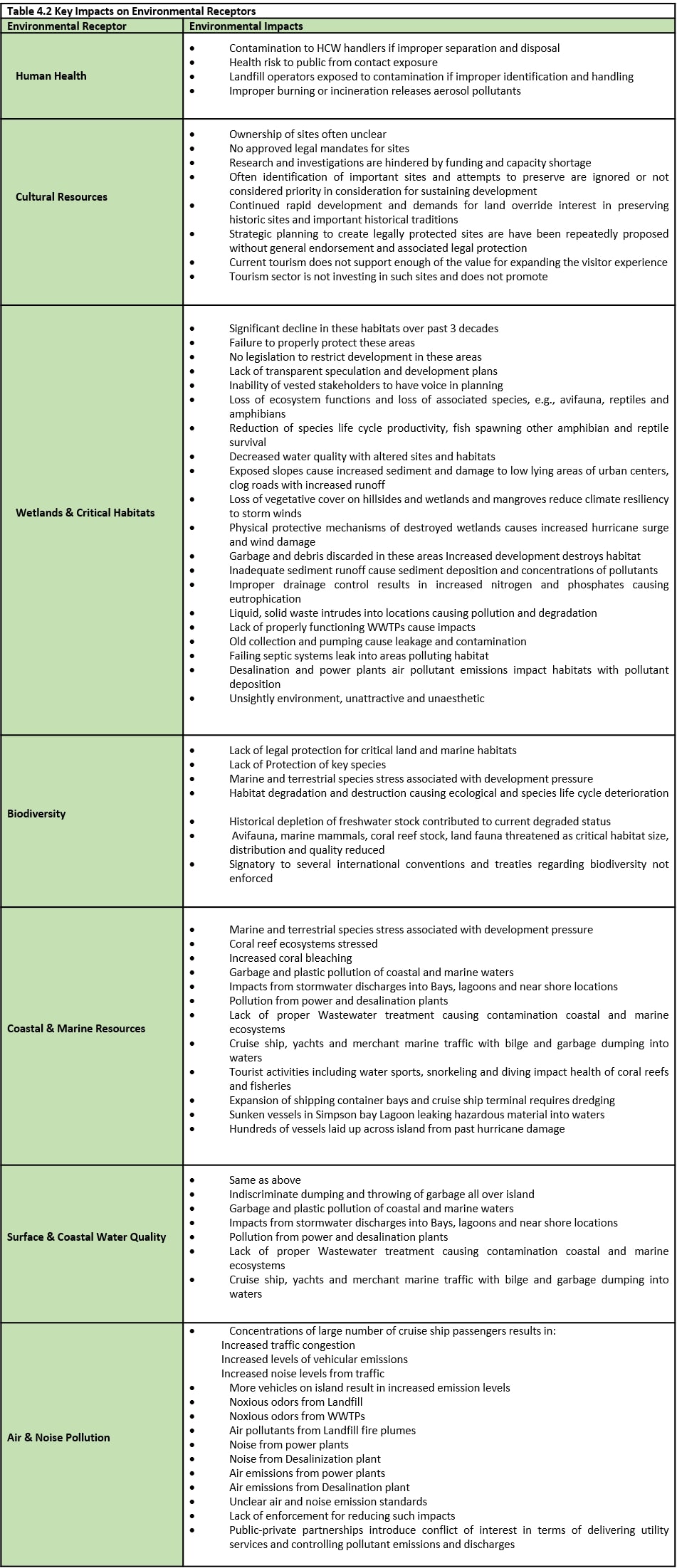
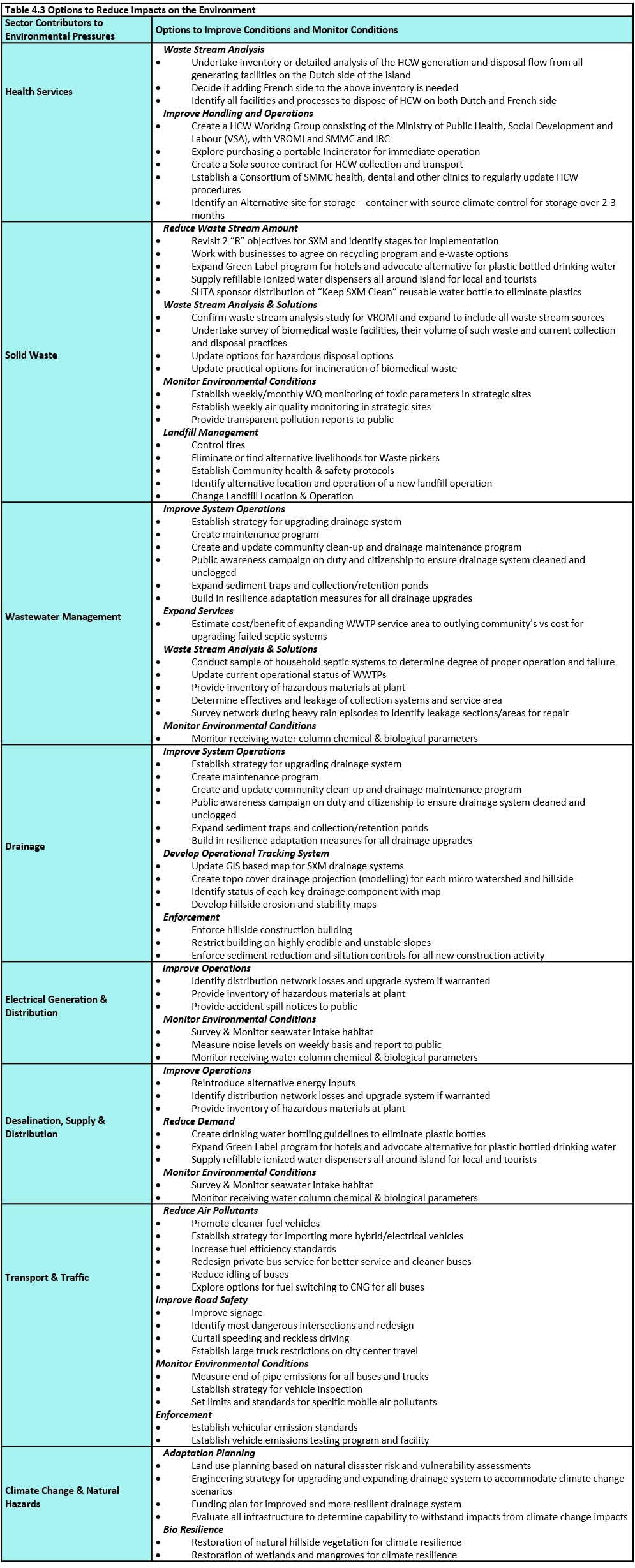
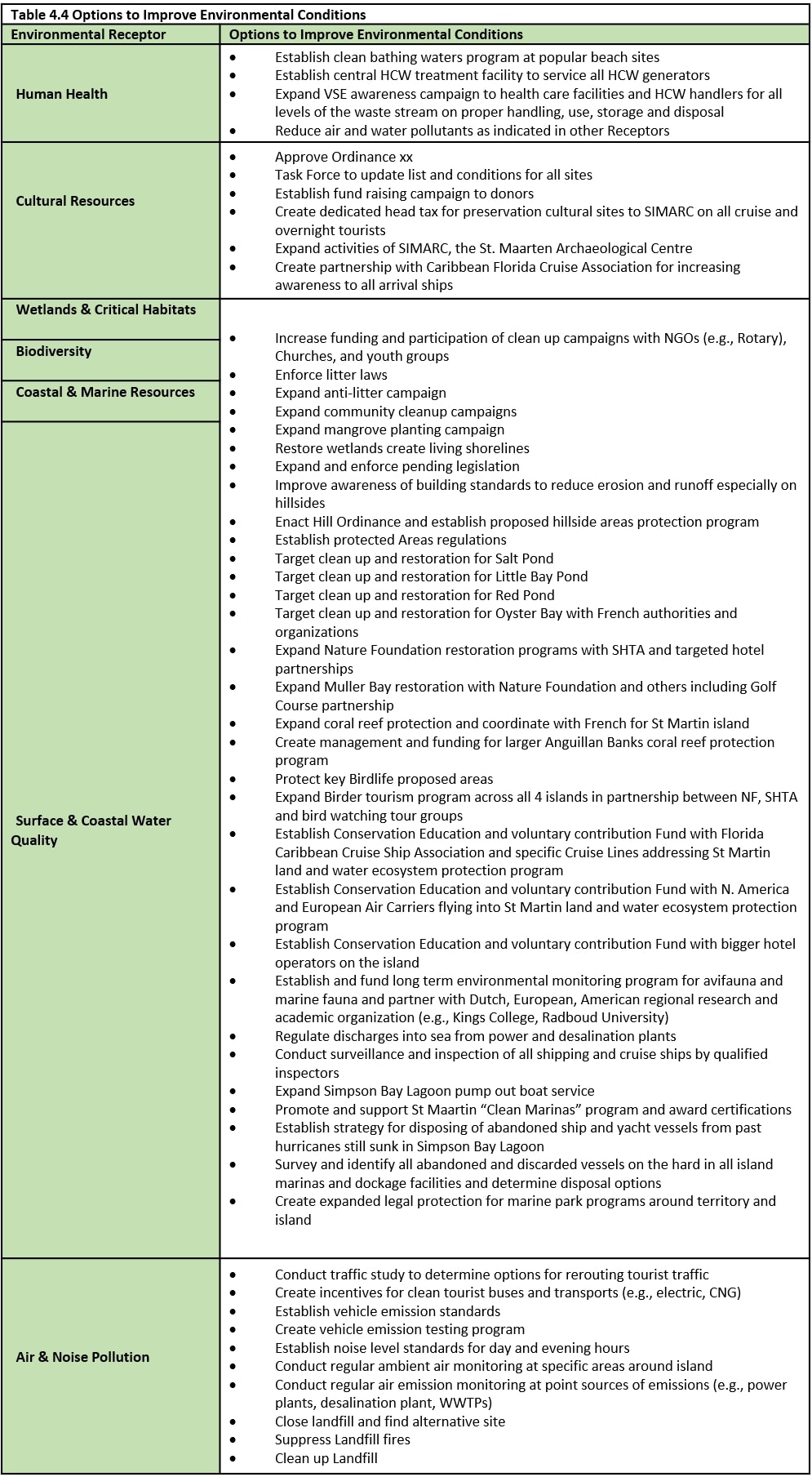
Appreciation of the multiple factors contributing to the growth of the economy, maintenance of the islands environment and natural resources (ENR) and well-being of the people of Sint Maarten are summed up figure 4.1. Major ENR pressures are associated with numerous public and private services (e.g., health services, solid waste management, wastewater management, electrical and drinking water supply) that collectively have both positive and negative impacts on the ENR. Continuing development growth requires maintaining and/or expanding these services. Additional sources of impacts are attributable to other essential infrastructure services such as the stormwater drainage system. The transport system is taxed to accommodate increasing traffic and the periodic heavy concentrations of tourists when there are extremely large capacity or multiple arrivals of cruise ships. These contributors are pictured in blue on the left side of the figure.
Table 4.1 takes each of these main stressors and corresponding aligned service contributors and shows the important ENR impacts. The analysis also considers how human health, cultural resources and key ENR features are impacted (see lists in table 4.2). It is clear to the reader that there are multiple stressors having similar or cumulative impacts across the islands ENR which is highlighted in figure 4.1 on the right side in green. Unfortunately, there is little quantitative measurements of these impacts, as explained in sections 1 and 2, yet the multiple studies, observations and conclusions from knowledgeable parties discussed throughout sections 1 and 2 provide ample evidence that such impacts have serious consequences and are exacerbated over time.
Tables 4.1 and 4.2 represent only part of the findings of this CEA study. Further insight provides more evidence regarding what actions/options are available to reduce, reverse or avoid such impacts. These options are presented for the sector contributors (table 4.3) and the ENR receptors (table 4.4).
In considering options to reduce the sector contributors to environmental pressures the synthesis factored in actions that contribute to a more informed analysis and understanding of how these sources pollute the environment, what parameters require further attention, options to reduce the amount of impacts in terms of volume or concentrations and specific system improvements. For most of these sources of ENR degradation and impact, there is a universal need to measure (monitor) impacts and include enforcement actions.
The contents of table 4.4 illustrate how numerous options to improve the environmental conditions have synergistic effects, meaning there is a multiplier effect which that can be interpreted as more “bang for the buck”. The range of actions varies from relatively simple and low cost to those options that require significantly more funding support and/or more technical and professional staff to undertake and conduct such initiatives.
FOCAL AREAS FOR ACTION
Going back in time to the days when the actual government in Saint Maarten was a directly under the authority of the Dutch government and Kingdom, there was recognition that a set of development policies and regulations were needed to provide for smart growth across the jurisdiction. After 2010, with the independence of the Dutch side of the island many of the regulations and laws were converted to local authority ordinances and decrees. The discussion of the issues around these stressors and contributors to degradation and decline of the islands environmental and natural resources still presents similar challenges with regard to managing both the growth of the jurisdiction and the sustainability of its resource base
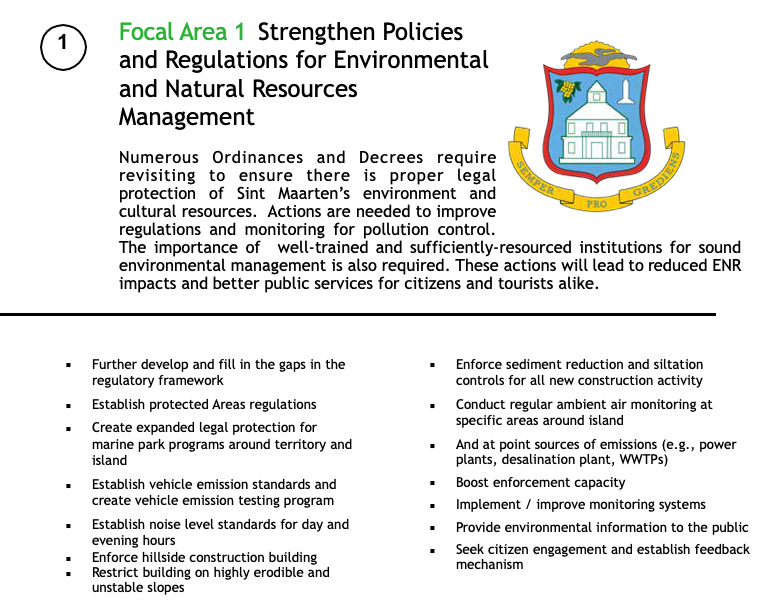
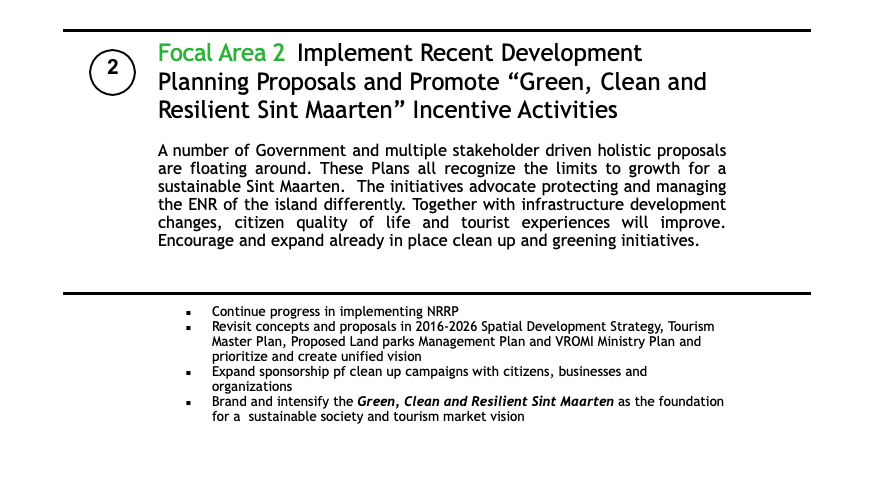
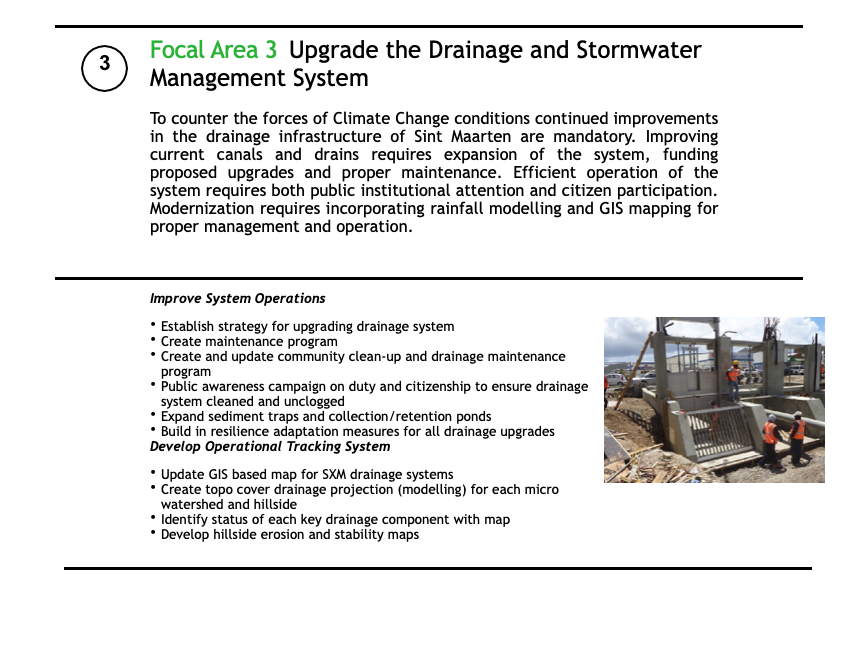
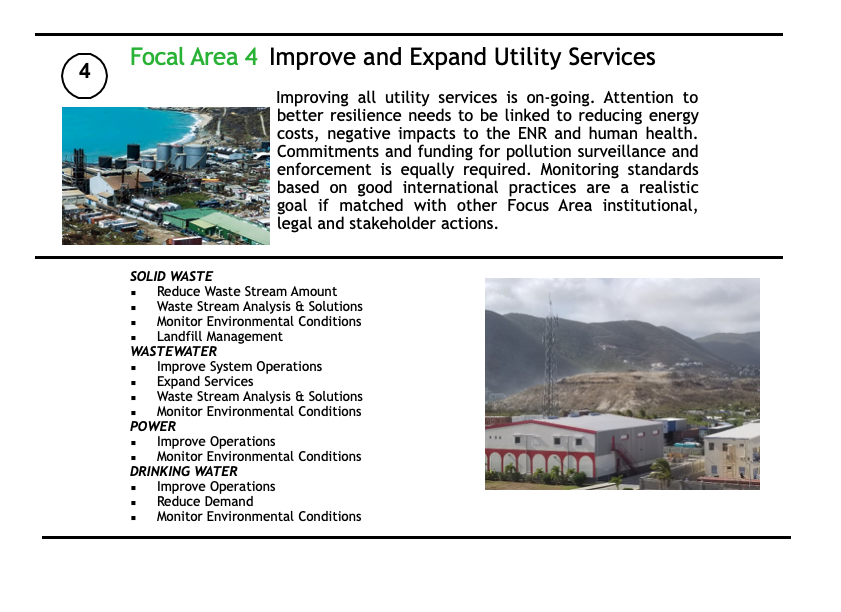
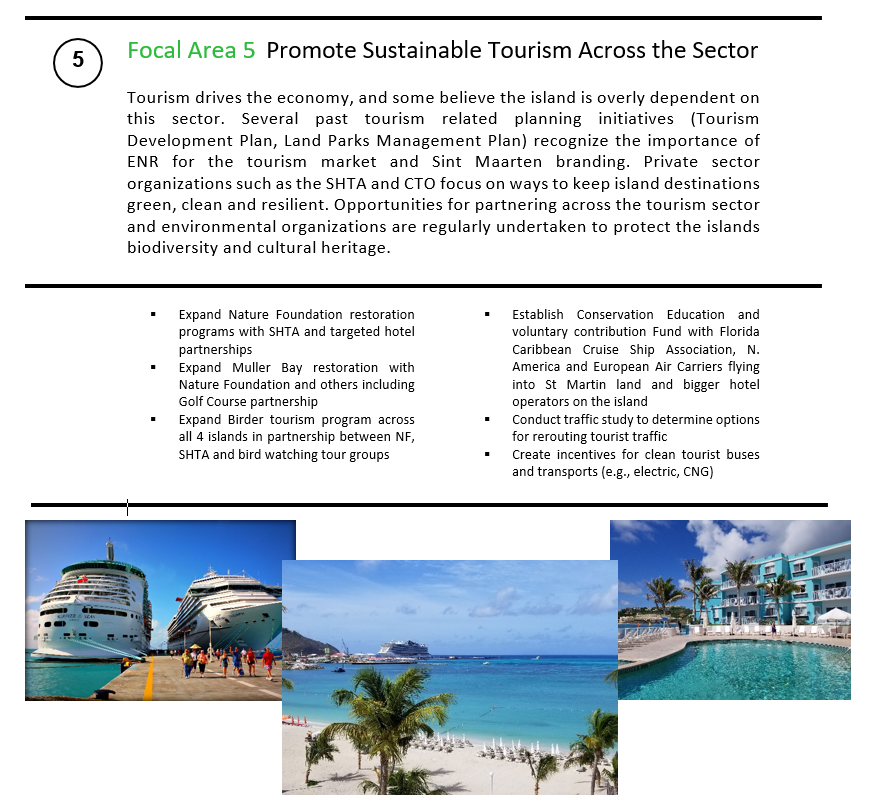
Five Focal Areas are promoted for Sint Maarten based on the drivers and environmental challenges discussed in this CEA. The first Focus Area considers the need to improve governance for environment, natural resources and sustainability and well-being of its citizens. This Focal Area represents a collective opportunity around the policies and regulations that have been pending and or have been recognized to be important and need to be promulgated in the near future.
The second Focal Area acknowledges that a number of past development planning initiatives have been promoted by various stakeholders. Most of these spatial, land use and development plans accept that there are limits to uncontrolled development on the island and sustainable development is widely recognized. Different themes and target sectors are analyzed many drawing a direct link to protection and management of the ENR of Sint Maarten.
The impacts of Climate Change continue to overload the drainage infrastructure of Sint Maarten from both fluvial events and sea level rise. Improvements such as expanding current canals and drains, funding proposed upgrades and proper maintenance. Efficient operation of the system requires both public institutional attention and citizen participation. Common practice to improve management of this infrastructure incorporates rainfall modelling and GIS mapping to identify locations constantly flooding, areas that need mitigation to reduce erosion, sediment loading and flash flooding. These issues are addressed under Focal Area 3.
Focal Area 4 addresses the challenges and opportunities across the utility sector. The provision of utility services in Sint Maarten from GEBE power and the desalinization plant are highly reliable. Treating wastewater remains a challenge and efforts at improving services with upgrading WWTPs and expanding such service has been a high priority matter for years. Solid waste and the concerns around HCW management continue to be problematic. Challenges include better resilience needs to be linked to reducing energy costs, negative impacts to the ENR and human health. Commitments and funding for pollution surveillance and enforcement is equally required. Establishing monitoring standards and surveillance would provide essential information on air and water quality.
Tourism drives the economy, and some believe the island is overly dependent on this sector. Focal Area 5 promotes sustainable tourism across the wider sector and stakeholders. The Focal Area features several past tourism related planning initiatives (Tourism Development Plan, Land Parks Management Plan) that recognize the importance of ENR for the tourism market and Sint Maarten branding. Private sector organizations such as the SHTA and CTO focus on ways to keep island destinations green, clean and resilient. Opportunities for partnering across the tourism sector and environmental organizations are regularly undertaken to protect the islands biodiversity and cultural heritage.
Climate Change emerges as a significant multiplier across all of the stressors and environmental impact pathways. The island knows all too well that the vulnerability to climate change will be a constant overarching threat and building resiliency is now more than ever a priority across society. This is reflected in the CEA repeatedly across all discussions and findings.
The compilation of this CEA remains a preliminary process, pending stakeholder consultation and priority setting. The attenuation of findings and recommendations with a time scale for near, medium and longer term outcomes and goals must also still be clarified. Lastly, the coupling of actions with cost and benefits requires additional input from knowledgeable experts and key government officials. These factors need to be assimilated in a practical fashion so that the norm of “Business as Usual” does not continue to plague a sustainable future for Sint Maarten.
